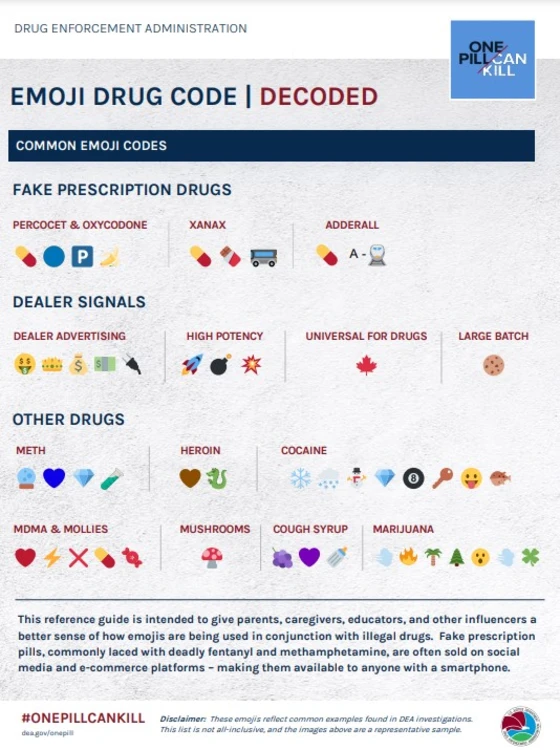Buying drugs via popular social media platforms like Snapchat is easier than you think. We’ll tell you how to know if it is happening and how to talk to your child about it before it happens.
Buying drugs via popular social media platforms like Snapchat is easier than you think. I was invited to speak about Internet safety at a small community group after a local high school student had a scare with psychedelic mushrooms he purchased from a “Plug” he met on Snapchat. A Plug is slang for someone who sells or distributes drugs online. The Plug directed him to use Telegraph, a cloud-based communication app usable across all devices; it allows users to send pics, videos, stickers, texts, and other files with end-to-end encryption. People involved in illegal online activities prefer messaging apps with end-to-end encryption to hide what they are doing from the police. The Plug sent Jared a menu of drugs he could purchase. Jared told the Plug he wanted mushrooms, and they arranged a meeting in a nearby park the same day.
Jared handed the Plug $50 through his driver’s window and left carrying a bag of mushrooms. Jared said when he got home, he ate the first mushroom and immediately felt the effects. Feeling pretty good, he ate one more, and that’s when things took a turn. He hallucinated heavily, believing the sun would crash into his home, and started panicking. He tore off his clothes and ran outside screaming. Not knowing what was happening, his father went outside to help him. He dragged his son back inside and found the bag of mushrooms. Not sure what to do, he and some friends corralled Jared into the living room and held him down for several hours until he regained his senses. They had the bag of mushrooms tested; one was laced with PCP, and another with fentanyl. Jared was fortunate he did not seriously injure himself or die. Unfortunately, many children are dying from accidental overdoses of drugs they’re purchasing online that are laced with fentanyl.
Becca Schmill, was an 18-year-old high school graduate on her way to the University of Richmond in Virginia. Becca was secretly using drugs, and in September 2020, Becca died from an accidental overdose after using drugs she purchased through Snapchat laced with fentanyl. Becca’s father, Stu Schmill, said, “We didn’t realize just how easy it was for her to have drugs delivered basically to our door.”
Fentanyl is a powerful synthetic opioid similar to morphine but is 50 to 100 times more potent. According to a May research letter published in JAMA, the overdose death rate for adolescents almost doubled in 2020, then rose by an additional 20 percent in 2021. “Fake prescription pills, commonly laced with deadly fentanyl and methamphetamine, are often sold on social media and e-commerce platforms,” the U.S. Drug Enforcement Administration warns.

Becca and Jared used a shorthand to find drugs through social media. Last year, the U.S. Drug Enforcement Administration released a parental guide to deciphering the “Emoji Drug Code,” a graphic bearing popular symbols repurposed for drug deals. For example, a pill emoji symbolizes drugs like Percocet, Adderall, or Oxycodone. Heroin is depicted with a snake or a brown heart, and cocaine is a snowflake. The emblem for marijuana is a palm or pine tree. And dealers indicate large batches of drugs with a cookie symbol, while high-potency substances are represented with a bomb or rocket emojis.
Here are a few ways you can protect your kids and prevent them from purchasing drugs online:
- Keep the communication lines open. Always have an open line of communication with your young loved ones. Let them keep you in the know about their friends, what’s happening in their school, their interests, and more. Being close to them also helps you notice behavior changes that could point to drug use.
- Make sure they know the consequences. Because the drugs can be readily available online, kids may believe they aren’t that dangerous. But often, dealers will lace pills with other substances (like fentanyl), increasing the drug’s potency and making its consumption even more hazardous. In addition to a possible overdose, using and buying drugs can lead to other consequences. There have been cases where someone has been sentenced to prison for giving a pill to someone who later overdosed.
- Check out their “searches” (if you suspect drug use). Look through their browser or Google searches (on their computer or cell phones). Keep an eye out for “How to buy ____ online” -type searches. Bring up anything that causes strong suspicion. This may be an uncomfortable conversation, and you may also be accused of spying (which you are technically doing). But be sure to let them know you are worried and only want to keep them safe. Make sure you point out recent cases in the news about young people overdosing on drugs.
- Monitor their online activity. Bark is a parental control app powered by secure advanced machine-learning algorithms that proactively detect and alert you to common online dangers and provides recommendations for discussing and addressing them as a family. Bark monitors text messages, YouTube, emails, and 24+ social networks for potential safety concerns like cyberbullying, self-harm, violence, sexual predators, and more. Use our promo code, “cybersafetycop,” to get a free one-week trial and 15% off for life.
- Give your child a safe phone you can manage. The Pinwheel smartphone gives a caregiver unprecedented control over how their child’s phone works. Easily enable/disable apps, control screen time, no unapproved calls, and monitor your child’s conversations as they learn healthy communication. Deleted texts still show. The Parent Portal provides deep insight into your child’s Internet safety. Use our promo code, “cybersafetycop,” to get a 10% off the cost of the device.
References:
“Teens are using emoji and secret lingo to find illegal drugs. How parents can crack the code,” https://www.today.com/
“Buying Drugs Online – What You Should Know & How to Protect Your Kids,” Get Smart About Drugs
*There are affiliate links throughout this post because we’ve tested and trust a small list of parental control solutions. Our work saves you time! If you decide that you agree with us, then we may earn a small commission, which does nothing to your price. Thank you!





